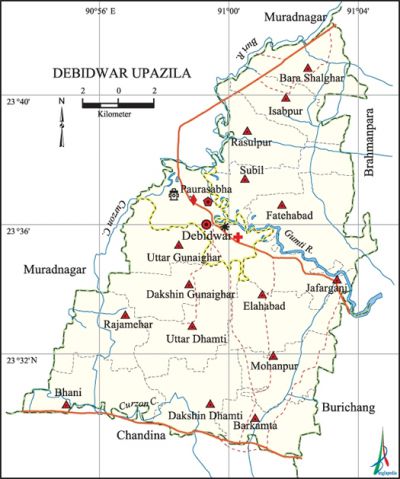Debidwar Upazila
Debidwar Upazila (comilla district) area 238.65 sq km, located in between 23°29' and 23°42' north latitudes and in between 90°59' and 91°05' east longitudes. It is bounded by muradnagar upazila on the north, chandina upazila on the south, burichang and brahmanpara upazilas on the east, Muradnagar upazila on the west.
Population Total 431352; male 204207, female 227145; Muslim 408638, Hindu 22677, Buddhist 3, Christian 11 and others 23.
Water bodies Main rivers: gumti, Buri; Bhinglabari canal, Curzon canal, Hasan Raja dighi, Deo dighi, Pan dighi, Dhamatipal dighi, Jotshna jalmahal and Bhiralla jalmahal are notable.
Administration Debidwar Thana was formed in 1915 and it was turned into an upazila in 1983.
| Upazila | ||||||||
| Municipality | Union | Mouza | Village | Population | Density (per sq km) | Literacy rate (%) | ||
| Urban | Rural | Urban | Rural | |||||
| 1 | 15 | 129 | 192 | 61418 | 369934 | 1807 | 60.6 | 51.5 |
| Municipality | ||||||||
| Area (sq km) |
Ward | Mahalla | Population | Density (per sq km) |
Literacy rate (%) | |||
| 21.05 | 9 | 22 | 61418 | 2918 | 60.6 | |||
| Union | ||||
| Name of union and GO code | Area (acre) | Population | Literacy rate (%) | |
| Male | Female | |||
| Isabpur 11 | 2965 | 8894 | 10403 | 56.4 |
| Elahabad 71 | 4039 | 13288 | 14489 | 52.7 |
| Uttar Gunaighar 53 | 3075 | 9085 | 10466 | 53.7 |
| Dakshin Gunaighar 59 | 3484 | 9818 | 11339 | 45.2 |
| Jafarganj 65 | 2964 | 12424 | 13427 | 46.3 |
| Dhamti 35 | 3763 | 9808 | 11133 | 53.0 |
| Fatehabad 47 | 5238 | 18628 | 21418 | 54.4 |
| Bara Shalghar 10 | 3430 | 8284 | 9238 | 60.7 |
| Barkamta 23 | 3248 | 15708 | 16255 | 55.2 |
| Bhani 83 | 3888 | 12221 | 13561 | 51.2 |
| Mohanpur 17 | 3441 | 13004 | 14060 | 48.2 |
| Rasulpur 89 | 3307 | 10411 | 11487 | 47.2 |
| Rajamehar 77 | 3776 | 11030 | 12451 | 53.8 |
| Subil 95 | 3638 | 9767 | 11263 | 46.6 |
| Sultanpur 41 | 4044 | 12537 | 14037 | 48.4 |
Source Bangladesh Population Census 2011, Bangladesh Bureau of Statistics.

Archaeological heritage and relics Baitul Azgar Jami Mosque (Gunaighar), Octagonal Shiva Mandir (Dhamti Bazar).
War of Liberation On 31 March 1971, an encounter was held between the Pak army and the Bangalis on the Comilla-Sylhet highways in which 33 Bangalis were killed. Besides, the Pak army conducted genocides and set many houses on fire on 7 August at Charkamta, 29 September at Jakerganj and on 14 November at Thana Sadar. Freedom fighters carried out operations at places like Barkamta, Debidwar Police Station, Barur, and Ponra gram of the upazila. A mass grave was discovered in the upazila at a place now known as the Muktijoddha Chattar (Freedom Fighters Square).
For details: see দেবীদ্বার উপজেলা, বাংলাদেশ মুক্তিযুদ্ধ জ্ঞানকোষ (Encyclopedia of Bangladesh War of Liberation), বাংলাদেশ এশিয়াটিক সোসাইটি, ঢাকা ২০২০, খণ্ড ৪।
Religious institutions Mosque 455, temple 27, tomb 9.
Literacy rate and educational institutions Average literacy 52.8%; male 54.4%, female 51.4%. Educational institutions: college 7, secondary school 47, technical school 3, madrasa 30. Noted educational institutions: Debidwar Reazuddin High School (1918), Gangamandal Raj Institution (1922), Dhamti Islamia Kamil Madrasa (1920).
Newspapers and periodicals Weekly: Debidwar and Comilla Kantha.
Cultural organisations Library 3, club 57, theatre group 1, press club 1.
Tourist spots Debidwar Municipal Park, Debidwar Municipal Children Park.'
Main sources of income Agriculture 54.17%, non-agricultural labourer 1.74%, industry 1.02%, commerce 14.04%, transport and communication 4.57%, service 11.82%, construction 1.22%, religious service 0.33%, rent and remittance 2.90% and others 8.19%.
Ownership of agricultural land Landowner 74.61%, landless 25.39%; agricultural landowner: urban 60.20% and rural 75.17%.
Main crops Paddy, wheat, mustard, corn, potato, vegetables.
Extinct or nearly extinct crops Tobacco, jute, kaun, sesame, peanut, maskalai, masur pulse, gram.
Main fruits Guava, litchi.
Fisheries, dairies and poultries Fishery 7, dairy 5, poultry 30.
Communication facilities Roads: pucca 147 km, semi-pucca 13 km, mud road 334 km; waterway 52 km.
Extinct or nearly extinct traditional transport Palanquin, bullock cart, horse carriage.
Noted manufactories Jute mill, cold storage, ice factory, brick field.
Cottage industries Blacksmith, potteries, weaving, net weaving, bamboo work, cane work.
Hats, bazars and fairs Hats and bazars are 15, most noted of which are Dighirpar and Rasulpur Hat, Ponrar Poush Sankranti Mela and Baishakhi Mela.
Main exports Potato, vegetables.
Access to electricity All the wards and unions of the upazila are under rural electrification net-work. However 69.4% of the dwellings have access to electricity.
Sources of drinking water Tube-well 93.8%, tap 2.2% and others 4.0%. The presence of arsenic has been detected in the shallow tube-well water of the upazila.
Sanitation 77.8% of dwelling households of the upazila use sanitary latrines and 18.1% of dwelling houses use non-sanitary latrines; 4.1% of households do not have latrine facilities.
Health centres Upazila health complex 1, hospital 1, family planning centre 12, CMH unit 1.
Natural Disasters The cyclone of 1991 caused death of more than one hundred persons and damages to a number of settlements of the upazila. Besides, huge damages to crops were done in 1988, 1998 and 2004 due to floods caused by damage of the flood protection dam on the river Gumti.
NGO activities brac, Pages, asa, nijera kari. [Md Mahmud Hasan Shamim]
References Bangladesh Population Census 2001 and 2011, Bangladesh Bureau of Statistics; Cultural survey report of Debidwar Upazila 2007.
